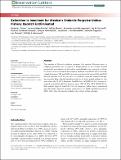Files in this item
Extinction is imminent for Mexico’s endemic porpoise unless fishery bycatch is eliminated
Item metadata
| dc.contributor.author | Taylor, Barbara L. | |
| dc.contributor.author | Rojas-Bracho, Lorenzo | |
| dc.contributor.author | Moore, Jeffrey | |
| dc.contributor.author | Jaramillo-Legorreta, Armando | |
| dc.contributor.author | Ver Hoef, Jay M. | |
| dc.contributor.author | Cardenas-Hinojosa, Gustavo | |
| dc.contributor.author | Nieto-Garcia, Edwyna | |
| dc.contributor.author | Barlow, Jay | |
| dc.contributor.author | Gerrodette, Tim | |
| dc.contributor.author | Tregenza, Nicholas | |
| dc.contributor.author | Thomas, Len | |
| dc.contributor.author | Hammond, Philip S. | |
| dc.date.accessioned | 2016-12-06T10:30:26Z | |
| dc.date.available | 2016-12-06T10:30:26Z | |
| dc.date.issued | 2017-10-12 | |
| dc.identifier | 245326996 | |
| dc.identifier | 81c5b838-7deb-4f70-8951-1fdb22ab0e24 | |
| dc.identifier | 85006421843 | |
| dc.identifier | 000412861500011 | |
| dc.identifier.citation | Taylor , B L , Rojas-Bracho , L , Moore , J , Jaramillo-Legorreta , A , Ver Hoef , J M , Cardenas-Hinojosa , G , Nieto-Garcia , E , Barlow , J , Gerrodette , T , Tregenza , N , Thomas , L & Hammond , P S 2017 , ' Extinction is imminent for Mexico’s endemic porpoise unless fishery bycatch is eliminated ' , Conservation Letters , vol. 10 , no. 5 , pp. 588-595 . https://doi.org/10.1111/conl.12331 | en |
| dc.identifier.issn | 1755-263X | |
| dc.identifier.other | ORCID: /0000-0002-2381-8302/work/47531648 | |
| dc.identifier.other | ORCID: /0000-0002-7436-067X/work/29591649 | |
| dc.identifier.uri | https://hdl.handle.net/10023/9938 | |
| dc.description | Primary funding was by Secretaria del Medio Ambiente y Recursos Naturales (Secretario R. Pacchiano). Mexican support was from SEMARNAT, CONABIO, CONANP, PROFEPA, SEMAR, and WWF-Mexico. US support from NOAA-Fisheries-SWFSC and The Marine Mammal Center. | en |
| dc.description.abstract | The number of Mexico’s endemic porpoise, the vaquita (Phocoena sinus), is collapsing primarily due to bycatch in illegal gillnets set for totoaba (Totoaba macdonaldi), an endangered fish whose swim bladders are exported to China. Previous research estimated that vaquitas declined from about 567 to 245 individuals between 1997 and 2008. Acoustic monitoring between 2011 and 2015 showed a decline of 34%/year. Here, we combine visual line transect and passive acoustic data collected simultaneously in a robust spatial analysis to estimate that only 59 (95% Bayesian Credible Interval [CRI] 22 – 145) vaquita remained as of autumn 2015, a decrease since 1997 of 92% (95% CRI 80%-97%). Risk analysis suggests that if the current, temporary gillnet ban is maintained and effectively enforced, vaquitas could recover to 2008 population levels by 2050. Otherwise, the species is likely to be extinct within a decade. | |
| dc.format.extent | 8 | |
| dc.format.extent | 650300 | |
| dc.language.iso | eng | |
| dc.relation.ispartof | Conservation Letters | en |
| dc.subject | Extinction | en |
| dc.subject | Illegal fishing | en |
| dc.subject | Line transect | en |
| dc.subject | Phocoena sinus | en |
| dc.subject | Totoaba macdonaldi | en |
| dc.subject | Vaquita abundance | en |
| dc.subject | Passive acoustic monitoring | en |
| dc.subject | C-POD | en |
| dc.subject | QH301 Biology | en |
| dc.subject | SH Aquaculture. Fisheries. Angling | en |
| dc.subject | DAS | en |
| dc.subject | BDC | en |
| dc.subject | R2C | en |
| dc.subject.lcc | QH301 | en |
| dc.subject.lcc | SH | en |
| dc.title | Extinction is imminent for Mexico’s endemic porpoise unless fishery bycatch is eliminated | en |
| dc.type | Journal item | en |
| dc.contributor.institution | University of St Andrews. Statistics | en |
| dc.contributor.institution | University of St Andrews. School of Mathematics and Statistics | en |
| dc.contributor.institution | University of St Andrews. Marine Alliance for Science & Technology Scotland | en |
| dc.contributor.institution | University of St Andrews. Centre for Research into Ecological & Environmental Modelling | en |
| dc.contributor.institution | University of St Andrews. School of Biology | en |
| dc.contributor.institution | University of St Andrews. Sea Mammal Research Unit | en |
| dc.contributor.institution | University of St Andrews. Scottish Oceans Institute | en |
| dc.identifier.doi | 10.1111/conl.12331 | |
| dc.description.status | Peer reviewed | en |
This item appears in the following Collection(s)
Items in the St Andrews Research Repository are protected by copyright, with all rights reserved, unless otherwise indicated.

